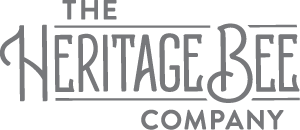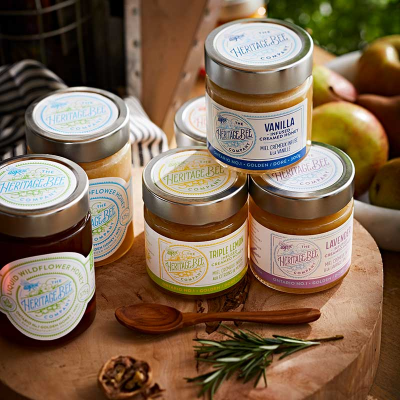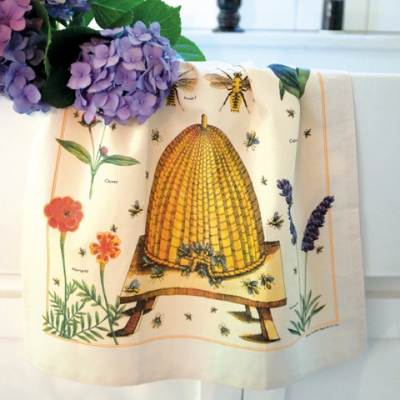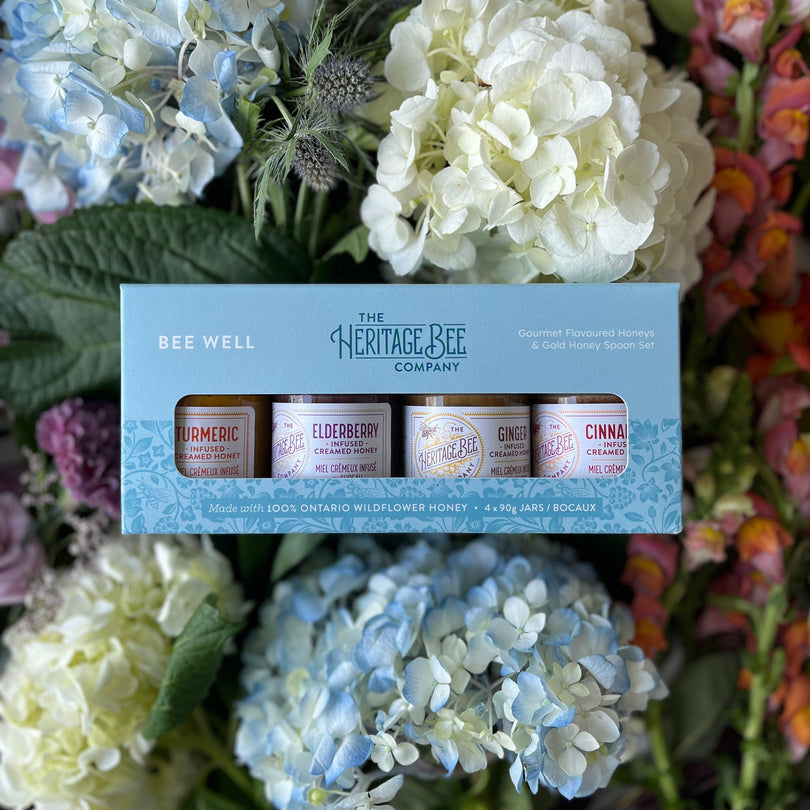FAQ
Honey Products
Yes to both. We hand-extract and cold process our honey near Creemore, Ontario, at a temperature below 100F. Our honey is not filtered but rather sieved to remove wax bits and bee body parts. Meaning all of the pollen and nutrients are maintained in each jar of our delicate honey.
No, we do not use synthetic chemicals, antibiotics or other drugs/medications to keep our bees healthy.
Honey crystallization is a natural process, and all honey will eventually crystallize. But don’t worry – it is still the same great-tasting honey! If you don’t like it in its crystallized form (it does make it less messy when eating it on toast!), simply put the jar into a warm pot of water, and leave it for a while. The warm water will turn the honey back to its liquid state. Be careful not to heat the honey too much or else you will break down all the beneficial enzymes in the honey and turn it into honey just like all the other honey you can buy in the supermarket that has been pasteurized.
Simply raw premium local wildflower honey. 100% Ontario wildflower honey. We do NOT import honey from other parts of Canada (such as Alberta), nor do we import from abroad. Why?
There are two main honey options – single source honey (i.e. buckwheat) and multi-source or polyfloral (i.e. wildflower). This refers to the food source of the honey bee. Did they have a buffet of flowers to choose from? Or were they forced to eat one single flower source for a period to produce specially flavoured honey?
At the Heritage Bee Co., we believe local polyfloral wildflower honey is much healthier to consumeю. It is in synchronicity with how the bees make honey naturally. There is a broader variety of food sources, offering a plethora of different nutritional benefits – both to the honeybee and to consumers, rather than one single variety.
Wildflower honey is truly honey as nature intended.
Honey is pretty much the only food on planet earth that does not spoil while in an edible state. Provided the honey has been appropriately stored – that is – well sealed and in a dry place, honey can last almost indefinitely. In fact, the Smithsonian has reported that pots of honey were recently discovered in Egyptian tombs. Scientists estimate that honey is thousands of years old and still edible! As honey is hygroscopic, it needs to remain below 18% moisture content, or it can ferment.
Creamed honey is simply crystallized honey blended with small refined honey crystals. These tiny crystals give the honey a very different and ‘smooth feel” rather than honey that has been allowed to crystallize naturally, which tends to be more ‘gritty.’
Yes, we do. Call Debbie at 705 466 BEES (2337) or email hello@heritagebee.com.
We strictly adhere to and follow international organic standards. It’s important as a honey consumer to understand the distinctions in honey. No synthetic chemicals, antibiotics or prohibited substances are used in our beekeeping pest management practice, resulting in a clean, pure, chemical-free, truly premium product.
More awareness is being brought to the adulteration of honey and unsustainable beekeeping practices around the world. At the Heritage Bee Co., we are doing our part to practice beekeeping in a manner that is in synchronicity with nature, which includes situating hives in countryside environments with an abundance of floral sources miles from industrial agriculture and pollution.
Seed Bombs
We recommend planting in a sunny location that gets at least 6 hours of sunlight daily. The Seed Bombs can be planted in a container or directly in the ground. Plant approx. 6 -10" apart. Only water if Mother Nature doesn't provide sufficient rainfall naturally.
You don’t need to be a Master Gardener or a bee & butterfly expert to help restore pollinator habitats. There are plenty of resources online, and our all-time favourite visual reference guide is “100 Plants to FEED THE BEES” by The Xerces Society. We reference this often and are inspired by the easy-to-use guide which covers North America. Not enough time? Try our SEED BOMBS for an easy way to help restore critical habitats for bees & butterflies.
Debbie & Jeff’s ALL-TIME FAVE Wildflowers/Shrubs:
• Anise Hyssop
• Aster
• Basil (let it go to flower)
• Bee Balm
• Black Eyed Susan
• Blazing Star
• Borage / Viper’s Bugloss
• Calamint
• Catmint
• Clover (ground cover in lieu of grass)
• Goldenrod
• Lavender
• Milkweed
• Mountain Mint
• Sedums
• ServiceBerry (Deb’s favourite shrub)
• Spiderwort
• Thyme (creeping)
• Wild Geranium
• Wood Mint
A seed bomb is an easy and fun way to plant wildflowers and provide food for butterflies and bees! They are small dirt balls, hand-made of clay, organic compost and seeds. They are ready for planting in your backyard, or you can toss them into a vacant patch. – filled with native plant species. They look like small marbles or truffles. All seeds are native and non-GMO.
This traditional method for sowing valuable seeds in balls of clay protects seeds from hungry birds and increases your flowers’ success. It’s a carefree gift for a lazy gardener,or a fun way to green your brown thumb.
Our Seed Bombs are hand-made and specially formulated by The Heritage Bee Co. Each bomb contains 100% native Ontario wildflowers.
THROW & GROW to save the bees!
Best to plant in the Fall or Spring, in a sunny location. Water is needed to help germinate the seeds.
• Gently press your seed bomb into the soil to a depth of about 1.5 ” (approx 4 cm). Plant in an area that is bright and sunny.
• Space about 1 ft. apart (30 cm)
• Watering is helpful if Mother Nature doesn’t provide it naturally.
If Mother Nature does not supply natural irrigation, we strongly recommend watering.
Fall planting allows the plants to develop and provide an earlier display of flowers in the spring.
If planted in spring, ensure rainfall is expected; otherwise, supplemental irrigation will need to be supplied.
Patience – like all things in nature – is required to grow wildflowers. Depending on location and weather conditions, one typically can expect blooms in 2 – 3 years.
Before you reach the beautiful blooms, know that your soon-to-be wildflowers can easily be mistaken for a week. It’s important to demarcate the area you are planting your seed bombs. We like to use veggie stakes to mark off our areas.
Watch this video from the UK about growing seed bombs and the importance of restoring habitats for bees and butterflies.
There are six delicious native pollinator plants in your hand-made Seed Bombs! The Heritage Bee Co. has carefully chosen each species to ensure sequential blooming throughout the foraging season. And, of course, food for our bees and butterflies.
Here are the flowers, listed in order of bloom time from Spring to Fall:
Purple Gayfeather (Liatris spicata) June – Aug.
Common Milkweed (Asclepia syriaca) June – Aug.
Brown-Eyes Susan (Rudbeckia triloba) July – Sept.
Bee Balm/Bergamot (Mondara fistulosa) July – Sept.
Purple Coneflower (Echinacea purpurea) July – Sept.
Smooth Aster (Symphyotrichum leave) Aug. – Oct.
Yes, indeed. The clay coating protects the wildflower seeds from birds and other seed-eating creatures.
General
If you have a honeybee swarm, please give us a call, and we will do our best to safely and ethically relocate the honeybee to our pollinator sanctuary or refer you to another beekeeper. We provide this service free of charge. Thank you for not calling an exterminator.
Once it is consistently below 10 to 12 C (50F), the bees cluster together in the hive to stay warm. At the centre of the cluster is their mom – the queen bee. The surrounding worker bees vibrate their wing muscles to generate heat and keep the queen warm. The cluster moves around the hive, consuming honey stores. It is said one cluster can consume up to 30 lbs of honey during the winter.
On warmer days in the winter, the bees may leave the hive to relieve themselves during a cleansing flight. Until these special flights, bees will hold their pee and poop. Often yellow polka-dotted snow can be seen around the hives.
While we would love to save every honeybee colony possible, we simply cannot attend to every cut-out as they can be quite involved. We suggest visiting the Ontario Beekeepers Association to find a local beekeeper to help with your situation. And to verify they are, in fact, honeybees – and not wasps or hornets.
Hive Hosting
Thanks for your interest.
Yes indeed. Feel welcome to email us at hello@heritagebee.com for our new WE HOST program, which has been split into two: a bee experience and personalized jars of honey.
We are currently fully booked for 2022. For hosting hives on your property in 2023 as part of our YOU HOST program, kindly complete our Pre-Approval Form, and we’ll bee in touch.
NEW DEADLINE! Application for 2023: September 30, 2022
All expressions of interest for hives as part of our You Host service in 2023 will be received before September 30, 2022. We will assess all applications and made decisions by October 31, 2022. Should you wish hives, please ensure your Pre-Approval form is submitted before September 30, 2022.
We are not open to the public for biosecurity and safety reasons. Furthermore, we are rarely around during the summertime, as we are in the wildflower meadows caring for the bees.
Due to Covid-19, we are not certain we will have any 2022 Bee Experiences available. Please visit our online store to check availability.
Yes! If arranged ahead of time, additional honey can be purchased directly from your hive – in jars with your personalized labels. Or we can bulk package your honey.
Otherwise, we have honey available for sale in our online store.
Bees need chemical-free land, ideally miles from industrial monocultures and pollution.
We only place hives on rural countryside property with a minimum of 5 acres that are free of the use of any herbicides, pesticides or chemical treatments. Just as nature intended. Plentiful and diverse food sources of pollen, nectar, and water nearby are essential. Hives need windbreaks to the west, plus direct sunlight exposure, ideally facing south and east, for at least 6 – 8 hours per day. If your rural property, organic farm, and/or gardens have a good supply of untreated (non-sprayed) fruit trees or native flowering plants, you likely have the perfect spot for bees.
In Ontario, honeybee colonies cannot be placed within 30 metres of a property line separating the hives' land from land occupied as a dwelling or used for a community centre, public park or other public assembly or recreation place.
As such, we focus on properties that are at least 5 acres in size.
Hives, with or without bees, cannot be located within 10 metres of a highway.
To learn more about the Ontario beekeeping laws, visit: Ontario Bees Act
We will visit your bee hive(s) every 14–21 days throughout the foraging season. Likely more frequent when hives are getting established in early Spring and/or if there are issues.
Happy sunny days with a gentle breeze (or no breeze at all…) are perfect for hive inspections. If the weather is wet, overcast or rainy, we won’t likely be checking on your bees. They aren’t too keen about us doing inspections on these gloomy days.
Apiary Tours / Bee Experiences
Yes, however, due to Covid, we have paused all Bee Experience. It is an incredible honeybee experience that is memorable. Visit our STORE to learn more about availability and pricing.
For biosecurity and privacy reasons, we do not accept drop-ins.
Tours are open to children aged 6 years and older. No maximum age.
Sorry, we do not allow dogs at our Main Apiary as we have free-range heritage chickens.
There are special dates reserved for our Bee Experience. Please visit our online store for dates and availability.
No drop-ins, please, as we are usually away from our Main Apiary in the field beekeeping!
Yes, we provide a bee jacket, veil and gloves (optional).
We strongly suggest long pants and closed-toed shoes. Absolutely no sandals, Birks and/or flip-flops.
A Visitor’s Guide will be provided to all paid and confirmed guests.
Yes indeed. Once you book a tour with us, we will send you a copy of our Visitors Guide. Lots of important information to make your experience with the bees magical!



